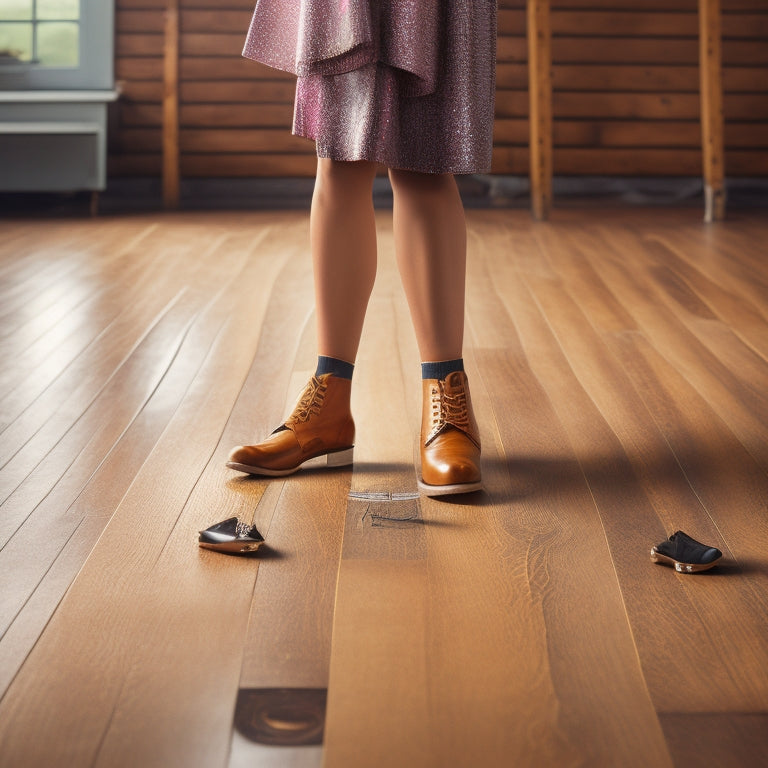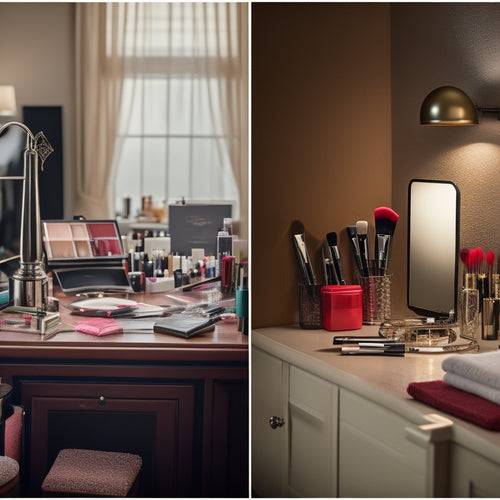
Can I Tap Dance on Plywood?
Share
You can tap dance on plywood, but the type of plywood you use can greatly impact your performance, from the sound quality to the safety of your dance floor. Softwood plywood offers a softer surface, while hardwood plywood provides a denser surface. The thickness of your tap shoes and the plywood itself also influence the sound and feel of your dance. By selecting the right combination, you can achieve the perfect balance. Now, get ready to take your tap dancing to the next level by discovering the secrets to ideal plywood selection and maintenance.
Key Takeaways
• Yes, you can tap dance on plywood, but the type and thickness of the plywood affect the sound quality and durability.
• Softwood plywood is less expensive but less durable, while hardwood plywood offers superior durability and a denser surface for better sound resonance.
• The thickness of tap shoes also impacts sound quality, with thin soles producing bright, crisp sounds and thick soles resulting in deep, rich sounds.
• Regular maintenance and surface preparation are crucial to prevent damage, ensure safety, and optimize sound quality on plywood floors.
• Consider alternative surfaces, such as Dance Tiles or Tap Marley, for a more ideal resonance and support for tap dancing.
Plywood Types and Tap Dancing
You'll find that different types of plywood, ranging from softwood to hardwood, can greatly impact the quality of your tap dancing experience. Understanding the history of plywood, from its ancient origins to modern manufacturing, helps you appreciate its versatility.
In the dance community, the right plywood type can make all the difference. Softwood plywood, like pine or fir, offers a softer, more forgiving surface, ideal for beginners or those who prefer a more subtle sound. Hardwood plywood, made from woods like oak or maple, provides a denser, more resonant surface, perfect for advanced dancers seeking a louder, crisper sound.
Thickness Matters for Tap Shoes
As you step onto the plywood floor, the thickness of your tap shoes becomes an essential factor in producing the desired sound and feel, with even a slight variation in sole thickness having a substantial impact on your overall performance.
| Tap Shoe Thickness | Sound Quality |
|---|---|
| Thin (1/8 inch) | Bright, crisp sound |
| Medium (1/4 inch) | Balanced, resonant sound |
| Thick (1/2 inch) | Deep, rich sound |
The evolution of tap shoes has led to a range of thickness options, each suited to specific dance styles and preferences. With advancements in dance floor technology, you can now optimize your tap shoes to produce the perfect sound on plywood floors. By choosing the right thickness, you'll be able to express yourself freely and take your tap dancing to the next level.
Softwood Vs Hardwood Plywood
With your tap shoes optimized for sound quality, it's time to contemplate the plywood floor itself, where the type of wood used can greatly impact your overall performance.
You'll find two primary options: softwood and hardwood plywood. Softwood plywood, often made from fir or pine, is generally less expensive but may lack durability.
Hardwood plywood, on the other hand, is crafted from denser woods like oak or maple, offering superior wood durability. When selecting plywood, consider the grading system, which rates the wood's quality.
Look for higher grades for a smoother, more even surface. While softwood might seem like a cost-effective option, it may not provide the same level of performance as hardwood.
Choose wisely, and you'll be tapping your way to freedom in no time!
Tap Shoes and Plywood Compatibility
Now that you've chosen the perfect plywood, it's time to think about the tap shoes that'll be tapping away on it.
You'll want to ponder how the shoes' materials and design will interact with your plywood's surface, because it can greatly impact the sound quality you're aiming for.
As you explore this essential compatibility, you'll discover that plywood thickness, surface preparation, and more all play a significant role in achieving the perfect tap dance experience.
Sound Quality Matters
You'll achieve the best sound quality when your tap shoes and plywood floor are perfectly in sync, producing a rich, crisp tone that resonates with every step.
To achieve this harmony, contemplate the acoustic reflection and sonic nuances of your setup.
Here's a breakdown of the key factors to ponder:
| Tap Shoe Type | Plywood Thickness | Sound Quality |
| Metal plates | Thin (1/4 inch) | Bright, sharp tone |
| Plastic plates | Medium (1/2 inch) | Balanced, crisp sound |
| Leather plates | Thick (3/4 inch) | Warm, rich tone |
Plywood Thickness Counts
Select the ideal plywood thickness to maximize the full potential of your tap shoes, as incompatible combinations can dull your sound quality. You want to make certain that your plywood surface resonates with every step, creating a rich, crisp sound.
Plywood history dates back to ancient civilizations, but modern thickness standards have evolved to cater to various applications. When it comes to tap dancing, a thickness of 3/4 inch or 18mm is ideal, providing the perfect balance between durability and responsiveness.
This allows your tap shoes to produce a clear, sharp sound, unencumbered by a surface that's too soft or too rigid. By choosing the right plywood thickness, you'll be free to express yourself through the rhythmic beats of tap dance.
Surface Preparation Needed
Prepare your plywood surface by sanding it to a smooth finish, ensuring your tap shoes can glide effortlessly and produce a consistent, rich sound. You want to eliminate any rough spots or splinters that might hinder your movements or scratch your shoes.
After sanding, consider applying a floor primer to create an even, non-porous surface. This step is essential, as it will help reduce the noise and vibrations that might disturb others.
Potential Damage to Plywood
Here's the output:
Tapping away on plywood can lead to scratches, dents, and even cracks, especially if you're wearing metal-plated tap shoes or using a particularly aggressive tapping style. To minimize damage, it's crucial to take into account the durability of your plywood floor.
| Plywood Type | Durability | Floor Stability |
|---|---|---|
| Thin (1/4 inch) | Low | Low |
| Standard (1/2 inch) | Medium | Medium |
| Thick (3/4 inch) | High | High |
When tap dancing on plywood, you'll want to prioritize floor stability to prevent accidents and ensure a smooth performance. By choosing the right type of plywood and taking care to maintain it, you can enjoy tap dancing on a stable and durable surface.
Noise Levels on Plywood Floors
As you tap dance on plywood, you're likely wondering how much noise you'll generate, and the answer depends on the type of plywood and your personal style. Plywood's acoustic properties play a significant role in determining the noise level.
Some plywood types, like those with a thicker core, can absorb more sound, reducing the overall noise. On the other hand, thinner or lower-quality plywood may produce a louder sound due to its poorer sound absorption capabilities.
Additionally, your tap dancing technique and the shoes you wear will also impact the noise level. Experiment with different plywood types and tap styles to find the perfect balance of sound and freedom of expression.
Slip Resistance and Safety
You'll want to take into account the slip resistance of your plywood floor before tapping your way across it, since a slippery surface can quickly turn a fun dance session into a hazardous one. Dance injuries can be severe, and a slippery floor can lead to falls, sprains, and strains. To guarantee your safety, consider applying floor coatings that provide adequate traction. Here are some popular options:
| Floor Coating | Slip Resistance |
|---|---|
| Polyurethane | Medium |
| Silicone-based | High |
| Epoxy | Very High |
| Acrylic | Low |
| Ceramic | High |
Choose a coating that suits your needs, and apply it according to the manufacturer's instructions. With a safe and slip-resistant floor, you can focus on perfecting your tap dance moves without worrying about accidents.
Alternative Surfaces for Tap Dancing
If plywood isn't your preferred surface, consider exploring alternative options that can help you perfect your tap dance skills. You might find that Dance Tiles provide the ideal resonance and support for your feet. These interlocking tiles are specifically designed for dance and can be easily assembled to create a spacious practice area.
Alternatively, you could opt for Tap Marley, a portable and versatile surface that's perfect for practicing on the go. Whichever option you choose, you'll be able to focus on mastering your craft without worrying about the surface beneath your feet.
With the right alternative surface, you'll be tapping your way to freedom in no time!
Maintaining Plywood for Tap Dance
As you begin tap dancing on plywood, you'll want to make sure your surface is always in top condition. To do that, you'll need to prepare the plywood surface, establish a maintenance schedule, and stick to regular cleaning routines.
Plywood Surface Preparation
By regularly sweeping and mopping your plywood surface, you're taking the first important steps towards maintaining a safe and durable practice area for tap dancing.
Next, it's important to make sure your plywood is of high quality. Opt for a high-grade plywood, with a smooth, even surface. Check the plywood grading to guarantee it's suitable for heavy use.
Surface sanding is also essential to prevent splinters and create a smooth surface for your taps to glide across. Sand in a circular motion, working your way up to a fine-grit paper for a silky finish.
With a well-prepared surface, you'll be able to focus on perfecting your tap skills, knowing your plywood floor can keep up with your energetic rhythms.
Plywood Maintenance Schedule
You'll want to establish a regular maintenance schedule to keep your plywood floor in top condition, guaranteeing it remains a reliable partner for your tap dancing practice.
This schedule should include regular plywood inspections to identify any signs of wear or damage. During these inspections, pay attention to any cracks, dents, or scratches that could affect the floor's performance.
Additionally, perform a moisture check to make certain the plywood isn't absorbing excess moisture, which can lead to warping or rotting.
Regular Cleaning Routines
Set aside time each week to sweep or vacuum your plywood floor, removing any debris that could scratch the surface or hinder your tap dancing performance. A clean floor is essential for a smooth and carefree tap dancing experience. By incorporating daily cleaning habits into your schedule, you'll guarantee your plywood floor remains in top condition.
Here are three daily cleaning hacks to get you started:
-
Quick Pick-Ups: Set a reminder to quickly sweep or vacuum high-traffic areas daily.
-
Dusting Delight: Use a microfiber cloth to dust your floor, removing dirt and dust that can damage the plywood.
-
Spot Cleaning: Keep a cleaning solution and cloth handy to quickly tackle spills and stains.
Weighing the Pros and Cons
When contemplating the art of tap dancing on plywood, one must carefully consider the advantages of improved rhythmic control versus the potential drawbacks of muffled sound quality. You'll want to weigh the pros and cons before making a decision.
On the plus side, plywood can provide a more controlled and quiet practice space, allowing you to focus on your technique without disturbing others. However, the sound quality may not be as rich as you'd like. Consider your personal preferences: do you prioritize sound quality or convenience?
Additionally, think about cost considerations: will the cost of plywood be worth the benefits it provides? By weighing these factors, you can make an informed decision that works best for you and your tap dancing needs.
Frequently Asked Questions
Can I Use Plywood With a Glossy Finish for Tap Dancing?
You can use plywood with a glossy finish for tap dancing, but be aware that the Glossy Tradeoffs may affect your moves - the Finish Effects might make your taps slippery, so adjust your style accordingly and own that floor!
Are There Any Plywood Types Specifically Designed for Tap Dancing?
Imagine yourself tapping away on a plywood floor, feeling the rhythm in every step. When it comes to choosing the right plywood for tap dancing, you'll find Birch options and Maple alternatives designed specifically for excellent sound and durability.
Can I Put a Rug Over Plywood to Improve Tap Dance Traction?
You can definitely put a rug over plywood to improve tap dance traction! Opt for a rug with a non-slip, rubber-backed rug material to guarantee maximum floor grip, giving you the freedom to tap away with confidence!
How Do I Clean My Plywood Floor After Tap Dancing?
"After your tap dance sessions, you'll want to clean your plywood floor to maintain its quality. Remove dance shoes and sweep the floor to prevent scratches, then mop with a gentle cleaner for easy floor maintenance."
Can I Practice Tap Dancing on a Plywood Surface Outdoors?
You can totally practice tap dancing on outdoor plywood surfaces! Just make sure the wood is weather-resistant and sealed properly. You'll also love how the outdoor acoustics amplify your tapping rhythms, giving you total freedom to express yourself!
Related Posts
-

3 Pro Tips to Overcome Makeup Task Procrastination
You're stuck in a never-ending cycle of makeup task procrastination, feeling overwhelmed by the complexity of the tas...
-

5 Best Free YouTube Dance Makeup Tutorials
You're ready to elevate your dance performances with stunning makeup looks, and we're here to help! Our top 5 free Yo...
-

Color Your World: Dance Pages Galore
Color Your World: Dance Pages Galore is a wide-ranging platform offering a diverse range of dance-inspired coloring p...


